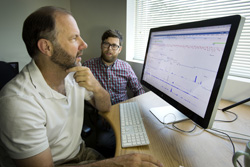ALBUQUERQUE, N.M. — To fight a pathogen that’s highly resistant to antibiotics, first understand how it gets that way.
Klebsiella pneumoniae strains that carry a particular enzyme are known for “their ability to survive any antibiotics you throw at them,” said Corey Hudson of Sandia National Laboratories in California.
Using Sandia’s genome sequencing capabilities, Hudson and colleagues Robert Meagher and Kelly Williams, along with former postdoctoral employee Zach Bent, identified several mechanisms that bacteria use to share genes and expand their antibiotic resistance. They found that in some cases, bacteria can receive a new set of genes all at once and in the process become pathogenic.

Sandia National Laboratories researchers Kelly Williams, left, and Corey Hudson view a segment of the Klebsiella pneumoniae genome around two genomic islands. The two researchers and their colleagues have identified several mechanisms that bacteria use to share genes and expand their antibiotic resistance. Click on the thumbnail for a high-resolution image. (Photo by Dino Vournas)
To better understand how the process works, they focused on the large mobile DNAs, such as plasmids, which exist as free DNA circles apart from the bacterial chromosome, and genomic islands, which can splice themselves into the chromosome. These mobile DNAs are major mechanisms for evolution in organisms that lack a true nucleus. Genomic islands and plasmids carry genes that contribute to everything from metabolism to pathogenicity, and move whole clusters of genes all at once between species.
Identifying how genomic islands move and their effect on bacterial physiology could lead to new approaches to bypass bacterial defenses, Hudson said.
Eventually, the effort might lead to a way to predict new pathogens before they emerge as public health threats.
“We’re just starting on this path,” Williams said. “It’s a harder problem to predict emerging pathogens, rather than just observe them. Determining what is pathogenic in the first place and how it might become more pathogenic is a research challenge.”
Bacteria share genetic material with other bacteria
Bacteria share genetic material through free virus particles or through a cell-to-cell process called conjugation, where one bacterium sends out a tube from its surface into another’s and injects genes into the other cell, Williams said.
A hypothetical example of sharing: A local water supply is contaminated with a pathogenic E. coli strain that is not antibiotic-resistant. Klebsiella pneumoniae enters the water, comes into contact with the E. coli, and donates genes. Now a pathogenic E. coli has acquired resistance, making it harder to eradicate.
“The great challenge is that bacteria can easily share their defenses,” Williams said.
Over the two decades that various bacterial genomes have been sequenced, researchers have found rampant gene sharing. “They are not so much generating new genes all the time — that does happen slowly — but what they mainly do is shuffle genes around,” Williams said. “The new gene combinations can quickly give bacteria a new pathogenic niche. They may then invade more tissues or survive in even more conditions.”
For the first time last year, Sandia microbiologists studying infectious diseases sequenced the entire genome of a Klebsiella pneumoniae strain that encodes New Delhi metallo-beta-lactamase (NDM-1). This enzyme makes the strain resistant to carbapenems, antibiotics of last resort. Klebsiella pneumoniae is the most common species of carbapenem-resistant Enterobacteriaceae (CRE) in the U.S., often having resistance to nearly all antibiotics in use. CREs also are dangerous because they can spread antibiotic resistance to other bacteria.
These opportunistic bacteria can grow on hospital surfaces or in lungs and tissues. The Centers for Disease Control and Prevention says about one in 25 hospital patients has an antibiotic-resistant infection, and it’s lethal in up to one in nine cases.
Since publishing the genomic analysis in June 2014, Sandia’s project has developed an experimental technique that detects genomic islands on the move. The team applies a computational or bioinformatics technique to identify islands in genomes and does particular studies of gene expression to see which antibiotic-resistance and other genes get turned on during an infection.
Research shows ‘the bug is always armed’
The research showed the beta-lactamase genes in Klebsiella pneumoniae were on all the time, whether or not the bacteria were infecting human cell cultures. In essence, Williams said, “the bug is always armed” against antibiotics.
The team built a database of genomic islands they found in a survey of all sequenced bacteria. So far, the database contains nearly 4,000 genomic islands — only a partial list of what bacteria share, Hudson said. The database reveals both global features of genomic islands and unique features in select groups of bacteria.
Rather than relying solely on such bioinformatics, the team invented a new experimental approach to detect islands as they pop out of the genome. The team stimulates this beginning stage of island mobilization by stressing the cells in certain ways. During this stage, the mobilized islands take circular form, independent of the chromosome. The islands are now free to move into other bacterial cells, bringing with them new sets of genes.
Experiments and bioinformatics work together, each yielding information the other did not and confirming each other. “We do what we can with the computer, but we like to test the resulting hypotheses in the lab,” Williams said.
Sandia National Laboratories is a multi-program laboratory operated by Sandia Corporation, a wholly owned subsidiary of Lockheed Martin Corp., for the U.S. Department of Energy’s National Nuclear Security Administration. With main facilities in Albuquerque, N.M., and Livermore, Calif., Sandia has major R&D responsibilities in national security, energy and environmental technologies and economic competitiveness.
Sandia news media contact: Patti Koning, pkoning@sandia.gov, (925) 294-4911, or Sue Holmes, sholmes@sandia.gov, (505) 844-6362